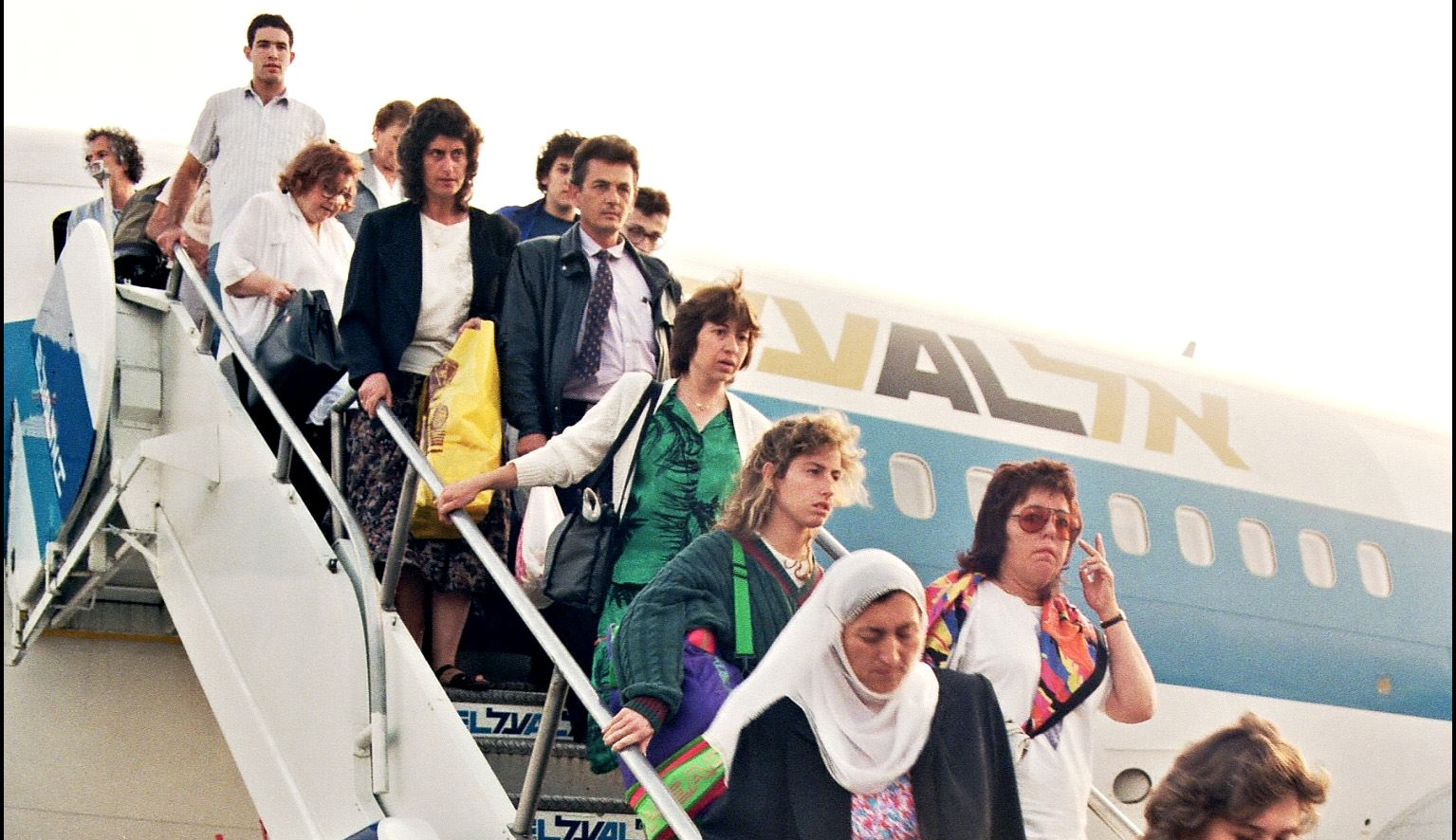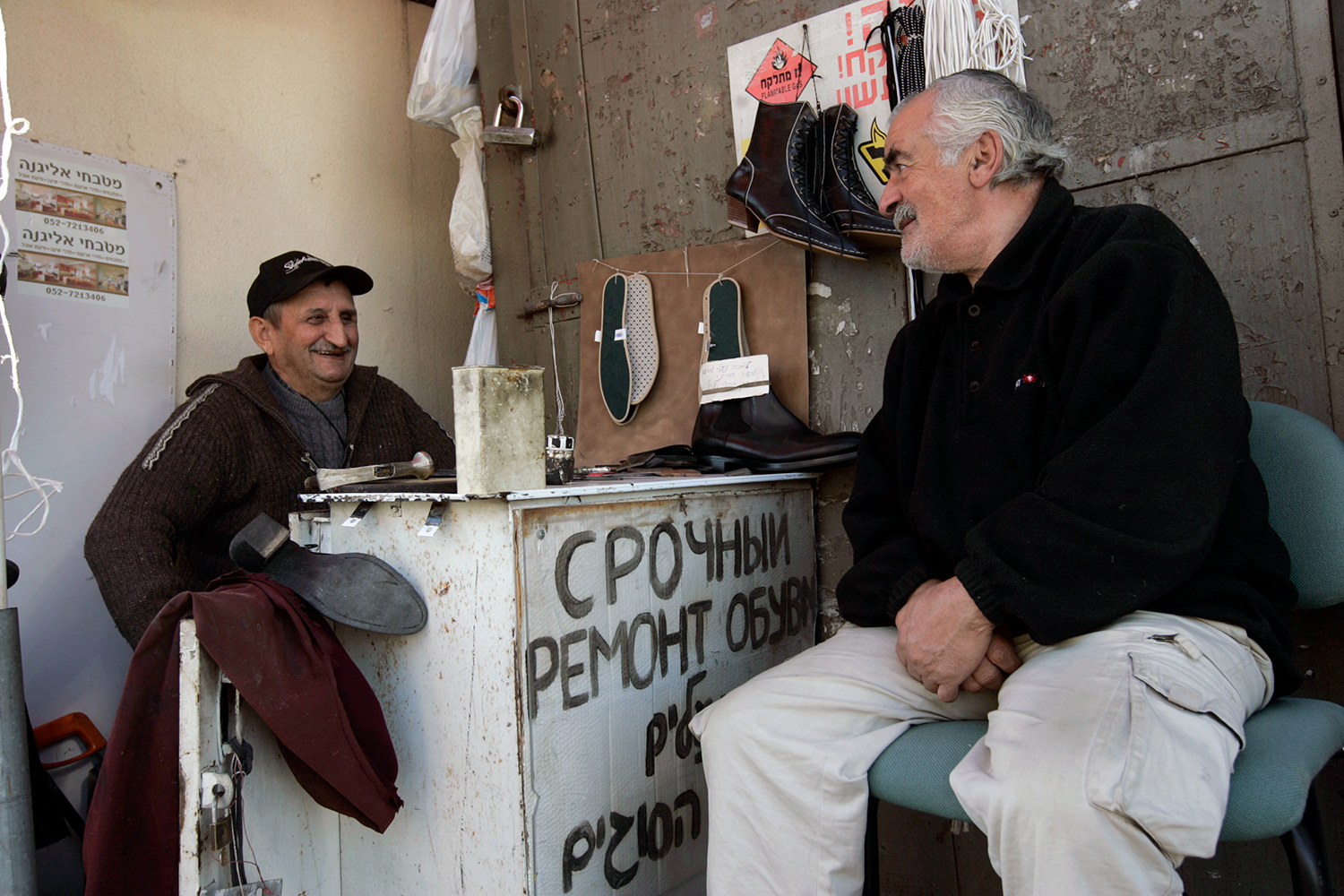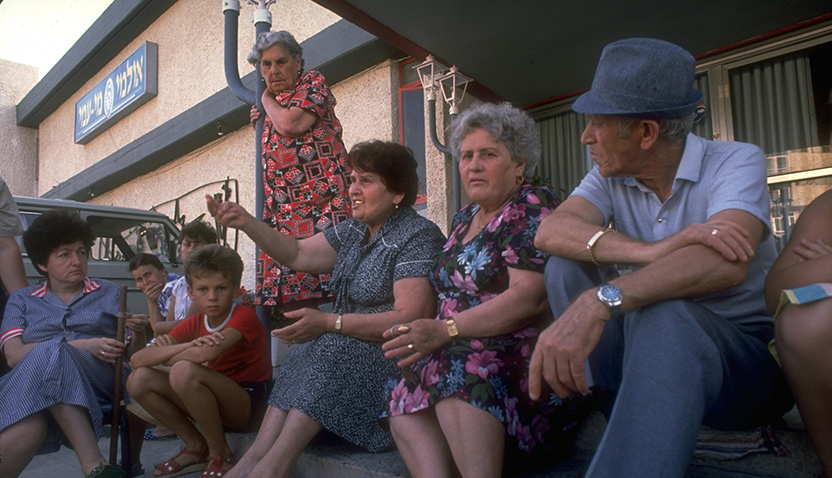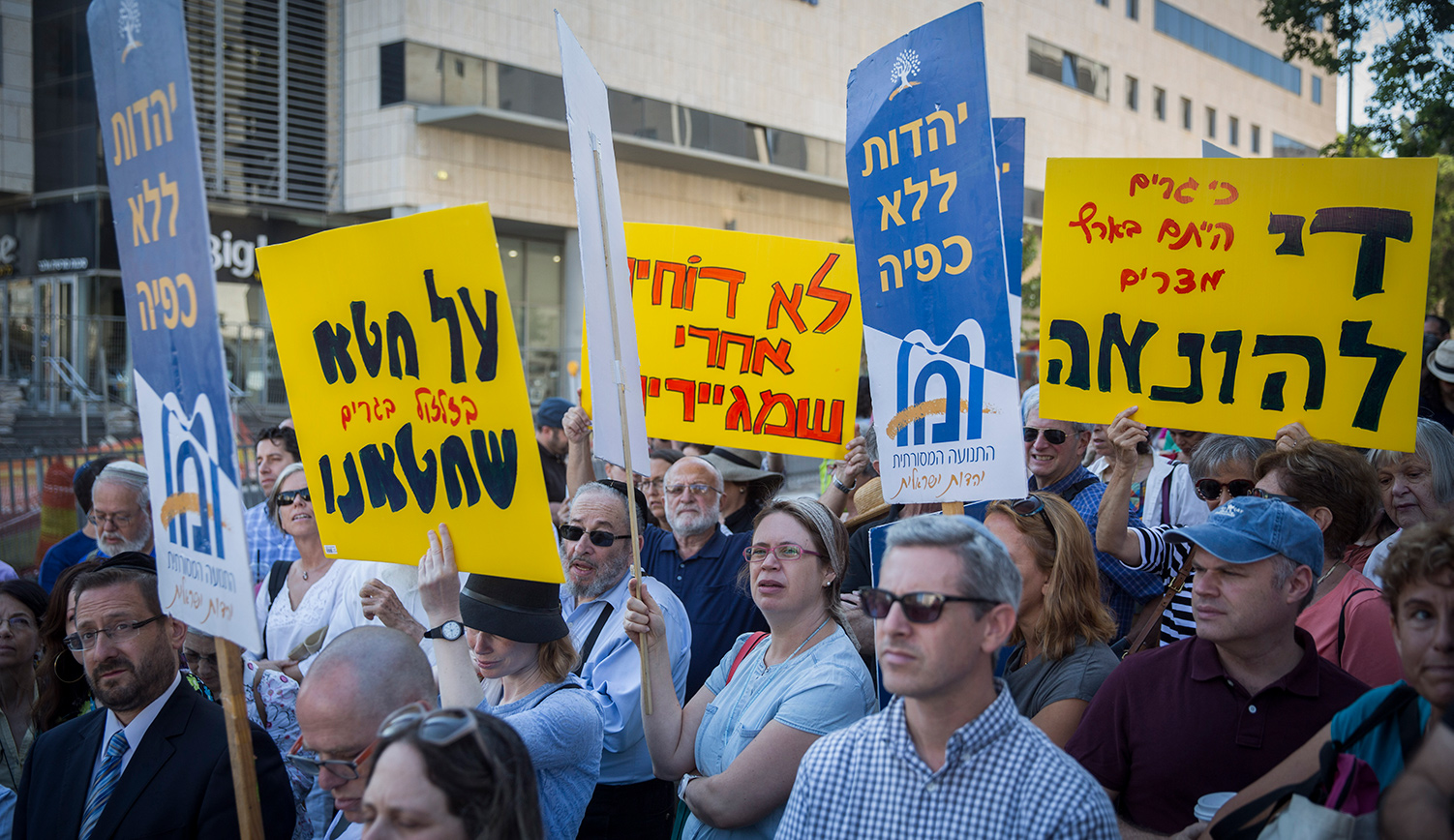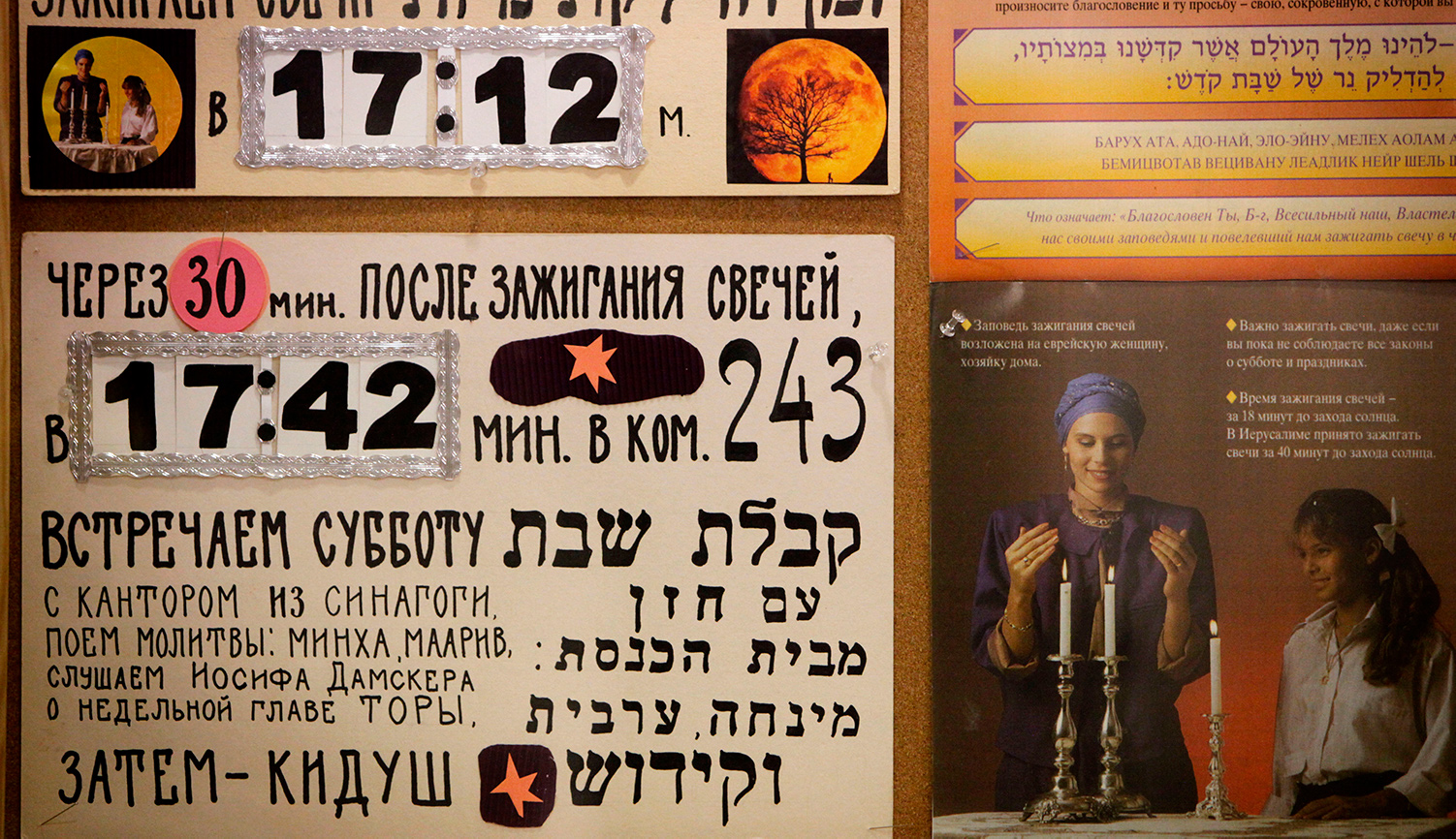In the summer of 1989, I left my home in Jerusalem for a reporting assignment in Europe, covering the fall of Communism from Warsaw to Berlin to Prague. A year later, I returned to a different Israel. In the supermarket there were strange cheeses and yogurt drinks labeled with Cyrillic writing, and unimagined, new products like frozen blueberries and cherries. On the streets, young musicians played cello and old men with gold teeth played accordion. The country suddenly felt as though it had become both less intimate and more claustrophobic: my daughter’s first-grade class was packed with 40 children to accommodate the immigrant influx.
I joined the staff of the recently founded Jerusalem Report magazine and was given the Russian beat. My editor, Ze’ev Chafets, told me that we Israelis are opening our home to hundreds of thousands of strangers, and none of us knows anything about who these people are. And so, I went out to learn. I sought intimate stories: a couple struggling to stay together as the husband became increasingly religious and his half-Jewish wife increasingly bewildered; the editor of a new Russian-language Israeli newspaper who had sat in the Gulag for Zionist activity but who felt himself an outsider to the Jewish story; a celebrated organist in the northern town of Carmiel who divided his time touring Europe and working as an Israeli garbageman.
The early 1990s not only brought a million Russian immigrants to Israel but tens of thousands of Ethiopians, who had been gradually arriving through the previous decade. The two immigrations were opposing images of each other: the Russians, with impressive secular education but the least Jewish knowledge of any immigrant wave; the Ethiopians, with little secular education but deep religiosity. Many Russians had come to Israel because it was as far West as they could reach; the Ethiopians had come to Zion. Inevitably, they regarded each other with suspicion and even loathing. In one absorption center I visited near Haifa, Russians and Ethiopians had to be housed in different areas after coming to blows.
“Why did Israel bring these primitives here?” a Russian man said to me, genuinely perplexed.
“For the same reason we brought you here,” I tried to explain. “Because you’re all part of the Jewish people.”
He laughed at my naïveté. “You brought us because we’ll be good for the economy,” he said. “The Ethiopians are just a burden.”
I wondered how these people would find their place in an Israeli story that they didn’t seem to understand.
With growing signs of imminent social and economic crisis, my reporting became increasingly urgent. I met with homeless Russian immigrants who had set up a tent encampment in a park at the entrance to Carmiel, and who wondered, reasonably, why they had come to a country that couldn’t even house them. Government ministers spoke of moving immigrant families into army barracks. The army, for its part, was hardly enthusiastic about the newcomers: There were reports of low motivation among Russian recruits and a rise in the ranks of alcohol consumption.
Reading Matti Friedman’s description of Alex Rif’s first day of kindergarten, I thought of Ofakim, a forlorn town in the desert that had inexplicably attracted a large Russian population. I had gone there to report on the first day of school, and found two little sisters—like Rif—wearing big bows that marked them as comically un-Israeli; they held hands, terrified, as other children laughed. Each wave of immigration had its own experience of dislocation when arriving in Israel. What traumas were we inflicting on the newcomers, on ourselves?
And yet, as Friedman reveals in his superb essay on the 30 years that have elapsed since the Russian aliyah, none of the dire predictions happened. Russians seem to have almost effortlessly slipped into Israeli society. The process, of course, was hardly painless. Outsiders were only vaguely aware of the years of hardship that preceded immigrants’ entry into the middle class: extended families sharing small apartments, exhausted parents working two or more jobs while grandparents raised the children. (The Russian grandmother should have received the Israel Prize for her contribution to immigrant absorption.)
As Friedman notes, the Russian immigration helped to prevent Israeli decline. At the end of the 1980s, Israel was barely managing to contain the Palestinian insurrection that became known as the first intifada. The war in Lebanon had turned into a quagmire. The economy was only fitfully emerging from hyper-inflation. We were a deeply divided society, governed by a barely functional “unity” coalition of Likud and Labor, neither of which could form a government on its own. Israel seemed stuck, adrift.
And then, unexpectedly, came this massive influx of immigrants that included a substantial part of the professional and cultural elite of a superpower. Not since the aliyah from Germany of the 1930s did Israel experience such an infusion of educated immigrants. We didn’t always know how to wisely use this gift, and we will never know how many brilliant careers were casualties of the exodus. Nevertheless, the immigrants infused Israel with creativity and excellence, and they helped prepare the way for Israel’s leading role in technological innovation and entrepreneurship.
What we learned about the Russians was their extraordinary resilience. They were, after all, survivors of the worst pathologies of the 20th century. As the immigrants were arriving, Saddam Hussein’s Scud missiles fell on Israeli cities. When their children came of age a decade later, during the second intifada, Palestinian suicide bombers blew up on our streets. A disproportionate number of casualties were Russian, since many of the bombings happened on buses, and relatively few Russians then owned cars. In no small measure, Russians became Israelis by fulfilling the rabbinic adage that the Land of Israel is acquired through suffering.
One of the worst atrocities of the second intifada was the 2001 suicide bombing of the Tel Aviv disco, Dolphinarium, killing 21 people, most of them Russian teenagers. A few days later I visited the largely Russian high school in Tel Aviv where many of the victims had studied. Students lit candles at a memorial display of photographs of their friends. I asked the young people, some of whom had just arrived in the country when the suicide bombings began and still spoke Hebrew hesitantly, how they were coping. Their restraint was stunning: this is the situation, they said, we’ll deal with it. The stoicism of the Soviet grandparents had passed to their Israeli grandchildren.
This was our least mythic aliyah, the least “Jewish,” and the most pragmatic. In some ways it was more an emigration than an exodus. Decades of Communism had seemingly succeeded in dejudaizing what had once been the world’s most Jewishly creative community—giving birth to Ḥasidism and the literary Yiddish and Hebrew renaissance and Zionism. Many years ago, I’d read an article about a Soviet Jewish dance instructor, nicknamed the Fred Astaire of Leningrad. Fred was proud to be a citizen of the great Soviet Union, he said, and had no interest in an outdated Jewish identity. The article was titled: “The Jew Who Never Heard of Yom Kippur.”
And yet many of the immigrants were, in their way, profoundly Jewish. How could it be otherwise for survivors of Stalin and Hitler? There remained—especially among immigrants from Ukraine and the Baltics and the Asian republics—a deep and visceral Jewishness, tempered by anti-Semitism but also nurtured by pride. That quality of character helps explain the ability of the immigrants to adapt to Israeli society.
For me, encountering the Russian aliyah meant closing a circle. In 1965, as a pre-bar mitzvah boy in Brooklyn, I joined the Student Struggle for Soviet Jewry (SSSJ), which had been founded a year earlier and launched the most successful protest movement in Jewish history. But it hardly seemed so at the time. We were a few dozen activists around the United States, competing for media attention with the rest of the 60s. As hard as it is to imagine now, the Soviet Jewry movement was, in its early years, the step-child of the Jewish community, barely funded and dismissed as either irrelevant or as mischief-maker disturbing the American Jewish quiet. The skepticism was hard to ignore. How, after all, would a small group of students influence a totalitarian superpower thousands of miles away? And did Soviet Jews even want to be saved? Maybe it was too late: maybe the Communists had already succeeded in erasing Jewish memory and longing.
And yet we were certain that we would win. It was inconceivable that the final chapter of the Holocaust would be the enforced disappearance of Soviet Jewry, the last great remaining community of Jews in Eastern Europe. Of course we would win: That was the logic of Jewish history.
Our faith was expressed in the streets. The Redemption March of Passover 1966 was led by a giant mural, depicting the Exodus from Egypt and the words: “As the Israelites crossed the Red Sea, so will Soviet Jews cross the Iron Curtain.” Sometime around then I asked Yaakov Birnbaum, the visionary British Jew who had come to New York to found SSSJ, how long he thought it would take to free Soviet Jewry. Twenty-five years, he answered without hesitating. A quarter century later, the Iron Curtain parted.
Sometimes I return to those early years and try to imagine what our reaction might have been had we been able to glimpse the end of the story. No doubt we would have been astonished to see the fulfillment of every one of our far-fetched predictions: American Jewry would be roused from its apathy and disunity and defeatism; Congress would link Soviet trade to Jewish emigration; the Soviet Union would be vulnerable to external pressure; Soviet Jews would overcome repression and fear and defiantly reclaim their Jewish identity; and all of this would end in a mass exodus. And yet, we believed, we knew; we would not have been astonished at all.
Before he died, blind and nearly forgotten, at age eighty-seven in 2014, Yaakov Birnbaum tried to create a Soviet Jewry Liberation Day that would preserve the memory of the struggle. He envisioned a day devoted to teaching its lessons—especially faith in Jewish perseverance and in the unity of the Jewish people. Given the current sense of drift within much of the Jewish community, we need that inspiration, that memory of awe for the Jewish story.
In absorbing a million Soviet emigres in the 1990s—preceded by the heroic first wave of 200,000 immigrants in the 1970s, “refuseniks” who fought their way out of the Soviet Union and prepared the way for their less heroic relatives and friends two decades later—the state of Israel completed its historic mission of retrieving the world’s persecuted Jews. The first stage was bringing Holocaust survivors home. Then came the Jews of the Middle East. (Imagine their fate today if they had remained in Syria, Yemen, Libya, Iraq.) And finally came the most improbable retrieval of all, the absorption of Soviet Jews, who only a few decades earlier had seemed lost to the Jewish people.
The 2,000-year exile ended not in 1948, with the creation of Israel, but only in 1989. Exile is the condition of enforced separation from the homeland; and with the fall of the Iron Curtain, there were no longer significant Jewish communities living in exile. (Today “exile” applies only to the remnant Jewish community of Iran.) Exile, now a choice, had been transformed into Diaspora.
The Soviet Jewry story is about the vindication of Zionism—but also, paradoxically, of Diaspora. Hundreds of thousands of Soviet emigres chose options other than Israel—for the most part America, but also Canada and Australia and, yes, Germany. And another million chose to remain in the former Soviet Union, where Jewish life has been renewed. In opting for free Diaspora communities rather than Israel, those Jews were also affirming, in their way, our post-exilic reality.
Still, without a state of Israel, we would likely have lost another three million Jews to the 20th century. It was Israel’s victory in the Six-Day War that galvanized young Soviet Jews into publicly and defiantly reclaiming their Jewish identity. It was Israel that quietly helped organize the international protest movement and recruited Jews from around the world to visit refuseniks. And finally, it was Israel that received the majority of the Soviet expatriates and ensured their re-integration into the Jewish people. Only in Israel, after all, does assimilation into the dominant culture work in favor of Jewish continuity.
The one counterpoint—a substantial one—to this astonishing success story is the uncertainty over the place in Israeli society of hundreds of thousands of emigres who are not halakhically Jewish. Many who tried to convert to Judaism were blocked by the increasingly ultra-Orthodox-run state rabbinic establishment. Ultra-Orthodoxy has become in Israel the gatekeeper of Jewishness—thwarting the final integration of émigré families into the Jewish people. The most galling example of this obstructionism is burying fallen soldiers of Russian origin who were not halakhically Jewish outside the gates of military cemeteries.
There is an irony here: The one part of the Jewish community that remained indifferent, even hostile, to the Soviet Jewry movement from its inception to its conclusion, were the ultra-Orthodox. Only a handful of ultra-Orthodox Jews were involved even in efforts to strengthen the Jewish identity of the millions of Jews trapped under Communism. (The noble exception was Chabad, whose extensive underground network in the Soviet Union was essential in the struggle against enforced assimilation.) And now, outrageously, the ultra-Orthodox are determining who among the Soviet emigres and their children will formally enter the Jewish people.
Still, the experience of the last 30 years tells us that Soviet Jewry’s return home is irreversible. One poignant indication of Israelization was when my daughter’s Russian friends, all of them single children when they arrived in Israel, became older siblings. The decision of Russian families to bring another child into the world—atypical in the failed society of the Soviet Union—was a sign not only of their growing economic success but of their internalization of the Israeli ethos. Soviet Jews had fled a blasted landscape, the spiritual equivalent of Chernobyl; it took them only a few years to understand that they had come to a country that believed in the future.
Sometimes I wonder what happened to those sisters in Ofakim, to the garbageman virtuoso in Carmiel. Reading Matti Friedman helps reassure me that they found their place here. And the Fred Astaire of Leningrad? I imagine his grandchildren living in Ashdod or Beersheva, somewhere in non-mythic Israel, naturally ordering their lives by the rhythm of the Hebrew calendar. Perhaps they fast on Yom Kippur.
More about: Aliyah, Israel & Zionism, Russian Jewry
